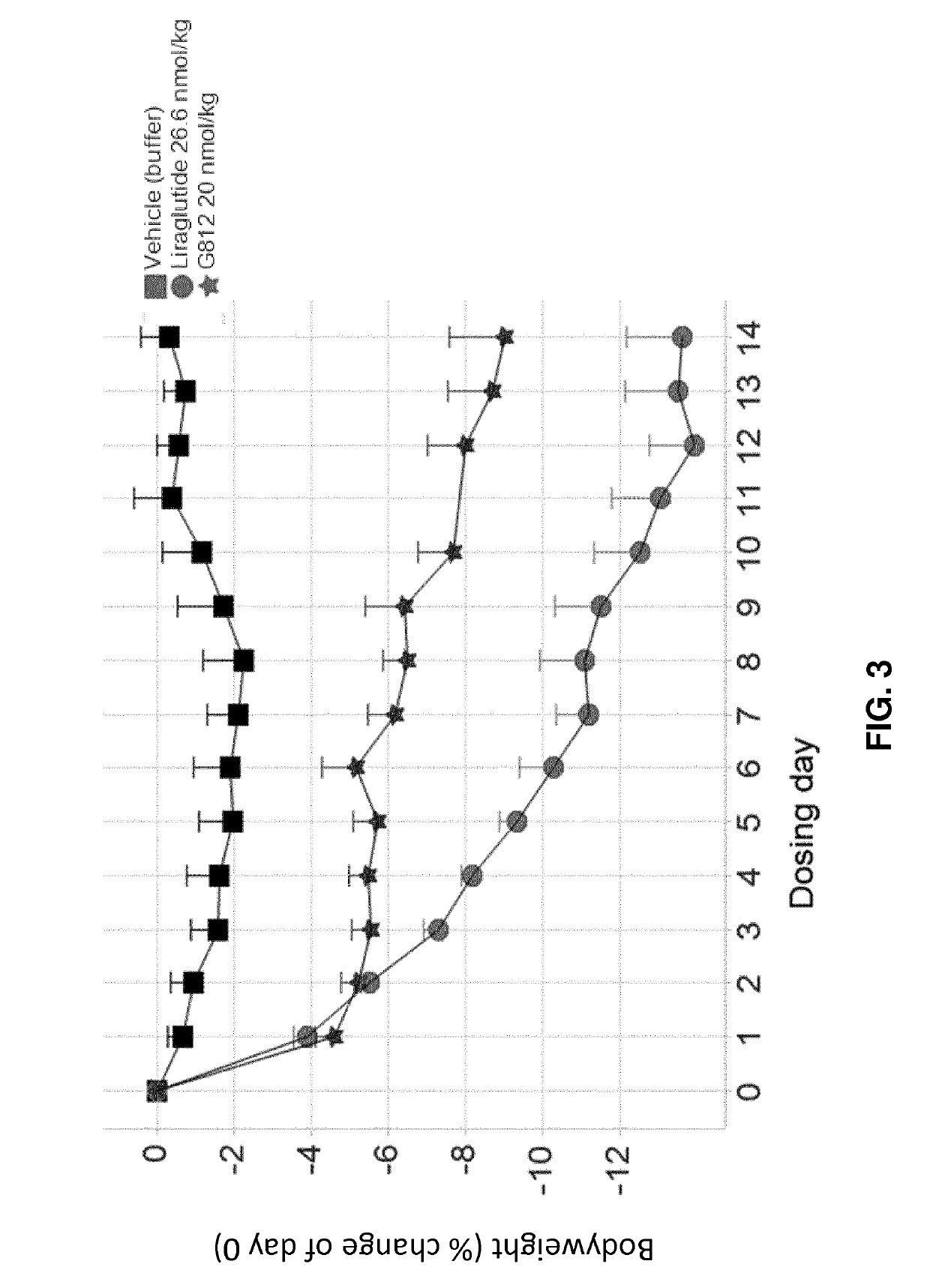Glucagon and glp-1 co-agonists for the treatment of obesity
a co-agonist and glucagon technology, applied in the direction of drug compositions, peptide/protein ingredients, metabolic disorders, etc., can solve the problems of increasing insulin resistance, no weight loss currently achieved, and major and growing health problems worldwide, and achieve the effect of reducing fructosamine levels
- Summary
- Abstract
- Description
- Claims
- Application Information
AI Technical Summary
Benefits of technology
Problems solved by technology
Method used
Image
Examples
example 1
, Modifications, and Characterization of GLP-1 / Glucagon Agonist Peptides
List of Abbreviations
[0164]Boc: tert-butyloxycarbonyl[0165]tert-Bu; tert-butyl[0166]DCM: dichloromethane[0167]DIC: diisopropylcarbodiimide[0168]Fmoc: 9-fluorenylmethoxycarbonyl[0169]HOBt: 1-hydroxybenzotriazole[0170]HPLC: High Performance Liquid Chromatography[0171]Mtt: 4-methyltrityl[0172]NMP: N-methylpyrrolidone[0173]Pbf: 2,2,4,6,7-pentamethyldihydrobenzofuran-5-sulfonyl[0174]TFA: trifluoroacetic acid[0175]TIS: triisopropylsilane[0176]Trt: triphenylmethyl, trityl
[0177]GLP-1 / glucagon agonist peptides were synthesized as follows. Elongation of peptide chains on NovaSyn TGR or preloaded Fmoc-Wang resin (NovaBiochem) was performed with a PRELUDE™ solid phase peptide synthesizer (Protein Technologies, Tucson, Ariz., USA). Manufacturer-supplied protocols were applied for coupling of the hydroxybenzotriazole esters of amino acids in N-methylpyrolidone (NMP). The fluorenylmethoxycarbonyl (Fmoc) group was used for the ...
example 2
Studies
Glucagon and GLP-1 Receptor Mediated cAMP Production
[0180]Biological Activity of Peptides in Cell-Based cAMP Activity Assay (Assay 1):
[0181]The biological activity of GLP-1 / glucagon agonist peptides synthesized by the method of Example 1 were tested for biological activity, e.g., stimulation of one or more cellular receptor responses, by the following methods. Stable cell lines expressing human, mouse, rat, or dog GLP-1 receptor (GLP-1R), glucagon receptor (GCGR) or glucose-dependent insulinotropic peptide (gastric inhibitory polypeptide) receptor (GIPR) were generated in HEK293s or CHO cells by standard methods. Peptide activation of these various receptors results in downstream production of cAMP second messenger which can be measured in a functional activity assay.
[0182]cAMP Assays were Performed Using “Assay Medium”:[0183]Assay Medium: 10% FBS in DMEM (Gibco #41966), containing 0.5 mM IBMX (Sigma #17018).
Low protein binding 384-well plates (Greiner #781280) were used to p...
example 3
tudies
[0210]G730, G797, and G812 (Study A).
[0211]Selected GLP-1 / glucagon agonist peptides disclosed herein were tested in a diet induced obesity (DIO) mouse model, as follows. Female C57 / Blb6JHsdOla (obtained from Harlan Laboratories, UK) were started on a high fat diet of D12492 (Research Diets, NJ, USA) and a chocolate confection, delicato ball (Delicata Bakverk, Sweden) at 9-11 weeks of age, and were maintained on the diet for 16 weeks prior to arrival to the animal facility, during a three week acclimation period and during drug treatment, caloric content of the two components of the diet is shown in Table 11. The mice were divided into 9 groups (n=5-6), and treatment was started at 29 weeks of age. The treatment groups and dosing are shown in Table 12.
TABLE 11Content of DIO DietTotalProteinCarbohydrateFatKcal fatKcal / Product(%)(%)(%)(%)gramDelicatoball (Delicata55331545.05Bakverk AB,Huddinge, Sweden)D12492 (research26.226.334.9605.24Diets, NJ, USA)
TABLE 12Treatment Groups for S...
PUM
| Property | Measurement | Unit |
|---|---|---|
| weight | aaaaa | aaaaa |
| body weight | aaaaa | aaaaa |
| body weight | aaaaa | aaaaa |
Abstract
Description
Claims
Application Information
 Login to View More
Login to View More - R&D
- Intellectual Property
- Life Sciences
- Materials
- Tech Scout
- Unparalleled Data Quality
- Higher Quality Content
- 60% Fewer Hallucinations
Browse by: Latest US Patents, China's latest patents, Technical Efficacy Thesaurus, Application Domain, Technology Topic, Popular Technical Reports.
© 2025 PatSnap. All rights reserved.Legal|Privacy policy|Modern Slavery Act Transparency Statement|Sitemap|About US| Contact US: help@patsnap.com



